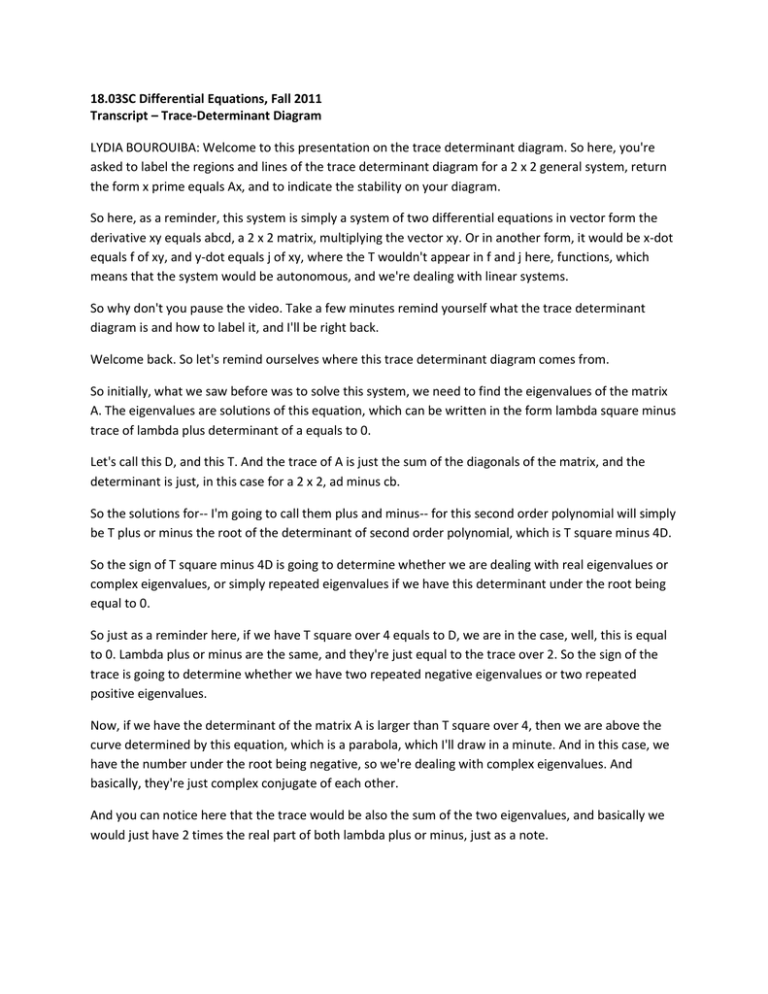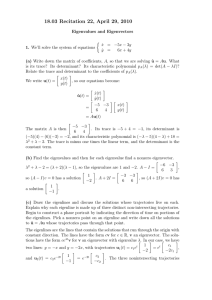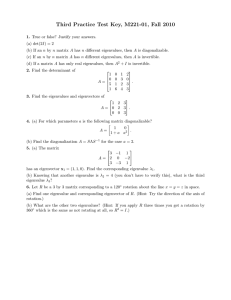18.03SC Differential Equations, Fall 2011 Transcript – Trace-Determinant Diagram
advertisement

18.03SC Differential Equations, Fall 2011 Transcript – Trace-Determinant Diagram LYDIA BOUROUIBA: Welcome to this presentation on the trace determinant diagram. So here, you're asked to label the regions and lines of the trace determinant diagram for a 2 x 2 general system, return the form x prime equals Ax, and to indicate the stability on your diagram. So here, as a reminder, this system is simply a system of two differential equations in vector form the derivative xy equals abcd, a 2 x 2 matrix, multiplying the vector xy. Or in another form, it would be x-dot equals f of xy, and y-dot equals j of xy, where the T wouldn't appear in f and j here, functions, which means that the system would be autonomous, and we're dealing with linear systems. So why don't you pause the video. Take a few minutes remind yourself what the trace determinant diagram is and how to label it, and I'll be right back. Welcome back. So let's remind ourselves where this trace determinant diagram comes from. So initially, what we saw before was to solve this system, we need to find the eigenvalues of the matrix A. The eigenvalues are solutions of this equation, which can be written in the form lambda square minus trace of lambda plus determinant of a equals to 0. Let's call this D, and this T. And the trace of A is just the sum of the diagonals of the matrix, and the determinant is just, in this case for a 2 x 2, ad minus cb. So the solutions for-- I'm going to call them plus and minus-- for this second order polynomial will simply be T plus or minus the root of the determinant of second order polynomial, which is T square minus 4D. So the sign of T square minus 4D is going to determine whether we are dealing with real eigenvalues or complex eigenvalues, or simply repeated eigenvalues if we have this determinant under the root being equal to 0. So just as a reminder here, if we have T square over 4 equals to D, we are in the case, well, this is equal to 0. Lambda plus or minus are the same, and they're just equal to the trace over 2. So the sign of the trace is going to determine whether we have two repeated negative eigenvalues or two repeated positive eigenvalues. Now, if we have the determinant of the matrix A is larger than T square over 4, then we are above the curve determined by this equation, which is a parabola, which I'll draw in a minute. And in this case, we have the number under the root being negative, so we're dealing with complex eigenvalues. And basically, they're just complex conjugate of each other. And you can notice here that the trace would be also the sum of the two eigenvalues, and basically we would just have 2 times the real part of both lambda plus or minus, just as a note. And in the third case, where we have that the determinant is below T square over 4, we're in the case where this number under the root is positive, so we're dealing with two real eigenvalues. So here, I should mention this is real. Lambda plus, lambda minus real. And we can have multiple cases. We can have lambda plus larger than lambda minus, both positive. We can have lambda plus, less than lambda minus, both negative. Or we can have lambda plus positive and lambda minus negative. And each case will give us a different behavior of the system. So let's first summarize this in this following determinant trace diagram, and then we'll start labeling this diagram. I should probably keep a little more space here. So this is basically D equal T square over 4 in our trace determinant diagram. I'm going to also erase this part and just keep it in dots. So in the first case that we looked at, we are in the case where we are right on this parabola. So that's the case where we have lambda plus equal lambda minus. And you can see that if the trace is positive, so if we are on the right hand side of the diagram, that we're going to have two positive eigenvalues that are both real, and they are repeated. So we can have multiple cases. We can have the case where we have a defective matrix, where basically here we only have one eigenvector associated with this repeated eigenvalue. And we have a defective case where we need to come up with a second eigenvector using the generalized eigenvector formula. And I'm not going to write this here, but I'm going to just to do the diagram. So for example, we would have one direction, V1, where we would have in this case lambda 1 and lambda minus positive. So in the phase base, in yx, the little diagram would show us that the solution are escaping from the critical point, the equilibrium point. And the second solution that we build would have a dependence in TV1, plus the second eigenvector V2 also directed by the positive eigenvalue. And so, we would have a solution, for example, that would look like this, with the solution escaping from the critical point because, again, we are in the case where the two eigenvalues are positive. And so here, we could have it in this form, or we can also have the diagram in the other direction. And I'll to it in the other direction on the other wing of the diagram. So this is the defective case. Defective node. The other possibility that we could have on this parabola-- and I'm going to just to it here-- will be the case where we actually have all the direction could be eigenvectors associated with this eigenvalue. And this would be, for example, for a diagonal matrix. In which case, all the directions would be escaping-- all the trajectories would be escaping-- from the critical point. And this would be a star. Obviously here, we are in the unstable case for the defective node, and we are also in the unstable case for the star, because all the solutions are escaping and basically going away. So if I start at the equilibrium and I perturb it a little bit, the solutions would want to escape from that equilibrium point. On the other side here, it would be exactly the same structure, except that I would have stability because the trace is negative. So I would have asymptotically stable star. Why asymptotically? Because basically, it's when T goes to infinity that the trajectories reach the critical point. And this is again in the phase base yx diagram. For the defective node, we would have this time, for example, direction V1 attracting the solutions, there ray V1. And the new trajectory that we will be constructing based on V1 again would be DV1 plus V2 generalized eigenvector. Both of them would give us solutions that converge toward the equilibrium, because the two eigenvalues here are negative. And so, we have that for large time, minus infinity follows V1, for plus infinity it's going toward the equilibrium points also follows V1. So the solutions would have to look like this, for example. And this would be asymptotically stable defective node. OK. So we're done with the points on the parabola. So now let's look at the other points, and I'll go maybe a bit less in the details. So for the case where we have the determinant larger then T square over 4, so we are just above this parabola now, we have the case where we have two complex eigenvalues. They are two complex conjugates. So let's assume that we can just expand our solution and write it in terms of the exponential, in terms of the real part of the eigenvalue. So it would be determined, again, the trace will give us the sign of the real part of the eigenvalue, multiplying a cosine and a sine. So we have something that is rotating in phase base, because we have basically the periodicity. But the distance to the critical point is changing, and it's either growing, if we have a positive real part for our eigenvalues, so if we are on this side. Or decaying if we are on the left side of the diagram. So that gives us typically spirals. So for example, that would be a spiral, going toward 0, toward the equilibrium point in phase base. And here, we would be in the case where we have instability due to the fact that the real part of the eigenvalue determining stability is positive. And so the solution of the trajectories escape from the critical point. And similarly here, we could have the same structure, but I'm just going to draw it in another direction. Where here, we would have stability. Oops. They should not cross. This is not the right way to draw this. And it would be going toward the critical point. So here, just a quick note. You can have this trajectory being drawn this way. So here, we have basically a clockwise motion. But we could also have it be drawn in the other way for both cases, giving us another direction of rotation in phase base. And the direction that you choose will be determined by the lowest left entry of your matrix A, and I will just explain quickly how we do that. OK. So we have basically here in stable spiral mode, and here it's again asymptotically stable a spiral. So what happens now if we are in this case. We're still above the parabola, so we have still complex eigenvalues. However, we have now the fact that the trace is equal to 0, which means that the eigenvalues don't have any real part. So basically, we have pure oscillation. And in the phase base, that corresponds to closed trajectories that could be circles or ellipses, basically. And so for example, we would have something in this form that would be called the center. And here again, you can have either counterclockwise or a clockwise rotation in phase base depending on the signs of the entries of your matrix. So one thing I want to note is that here, the stability for the center we say that it's simply stable, and not asymptotically stable, because the solution never actually reaches the critical point, but stays in the region around the critical point. So we're left with a few other cases that are now all below the parabola. And for that, we just have real eigenvalues. So let's look at the case where the eigenvalues have two different signs. So for that, we have to have the determinant being negative. So this whole lower part of the diagram, because the determinant is the product of the two eigenvalues. So if they have different signs, we're in this region. So in this case, we could have, for example, one eigenvalue with associated eigenvector V1 being negative. So the trajectories along this ray would be going toward equilibrium point. And then the other eigenvalue will be positive. So for example, lambda 2 here would correspond to this other eigenvector V2. And so here, we would have solutions that would be close to V1 when we're coming, for example, from minus infinity approaching the critical point. And then going back, approaching V2 when we go at T plus infinity, for example. And so it gives us pseudo-hyperbola form here, of this form. And this is said to be unstable, because all those solutions do not go to the critical point. But we have some stable manifolds. For example, the V1. If we start on this ray, we would be going toward the critical point. And if we start at the critical point itself, it would stay at the critical point. But it is unstable. So now what happened in these two different regions to finish. In these two different regions-- and I'm going to have a little bit more space here-AUDIENCE: It's called a saddle. LYDIA BOUROUIBA: Oh, yeah. Thank you. And this would be a saddle, and it's just because of the shape. I'm going to just add a little bit of space here, so that we can complete the diagram. I'll be basically looking at the regions here in the wedge, where we are below the parabola. And I'm looking for another color. Maybe I'll just use white. Now we are in the case where we would have two eigenvalues. Both real, so no oscillation. But let's say both positive, because we're basically on the region where the trace is positive. Let's say that we have one ray, V1. One ray, V2. The trajectories are going away from the critical point, because the two eigenvalues are positive. And now, what do the other trajectories do, where they follow-- so for example, they would be following V2. And I'm going to explain how. So here, we're in the case where obviously we're unstable, because again, the solution, the trajectories are going away from the critical point. And here, how do you pick which ray do you follow when you get closer to the critical point? Where in this case, we would be in a situation where we have lambda 2 smaller than lambda 1, larger than 0. So basically, the lambda 2 that is the closer to 0-- and that's also the case for the positive and the negative eigenvalues-- is the one that determines the solution closer to the critical point. And the larger in absolute eigenvalue and its ray then determines the behavior-Oh, sorry. There's a mistake here. It should be lambda 1. I said it, but I think I wrote it reversely. Yeah The eigenvalue closer to 0 is the one that determines the behavior at 0. So here, when we're going to infinity, the larger eigenvalue lambda 2 will determine the behavior, and the trajectories will become more and more parallel to V2. So what happens on this side would be exactly the same diagram, and I'm just going to do it with the same-- let's say, V2 here. Except that we would have our trajectories going toward the critical point. And the trajectory here again would be closer to V1, which means that we would have a case where we have lambda 1 less than 0 and larger than lambda 2. So that finishes roughly the diagram. I didn't detail a few borderline regions. For example, the region where the determinant equals to 0. And we will discuss that in another recitation. And the case also at which the determinant and the trace are equal to 0. So we'll detail that also. But try to think about it to complete the diagram. So the key points here were to remember what is the determinant trace diagram, how to basically deduce the nature of the eigenvalues based on T and D, their sign. And where to place the different structures on this determinant trace diagram. And that ends this recitation. MIT OpenCourseWare http://ocw.mit.edu 18.03SC Differential Equations. Fall 2011 For information about citing these materials or our Terms of Use, visit: http://ocw.mit.edu/terms.








